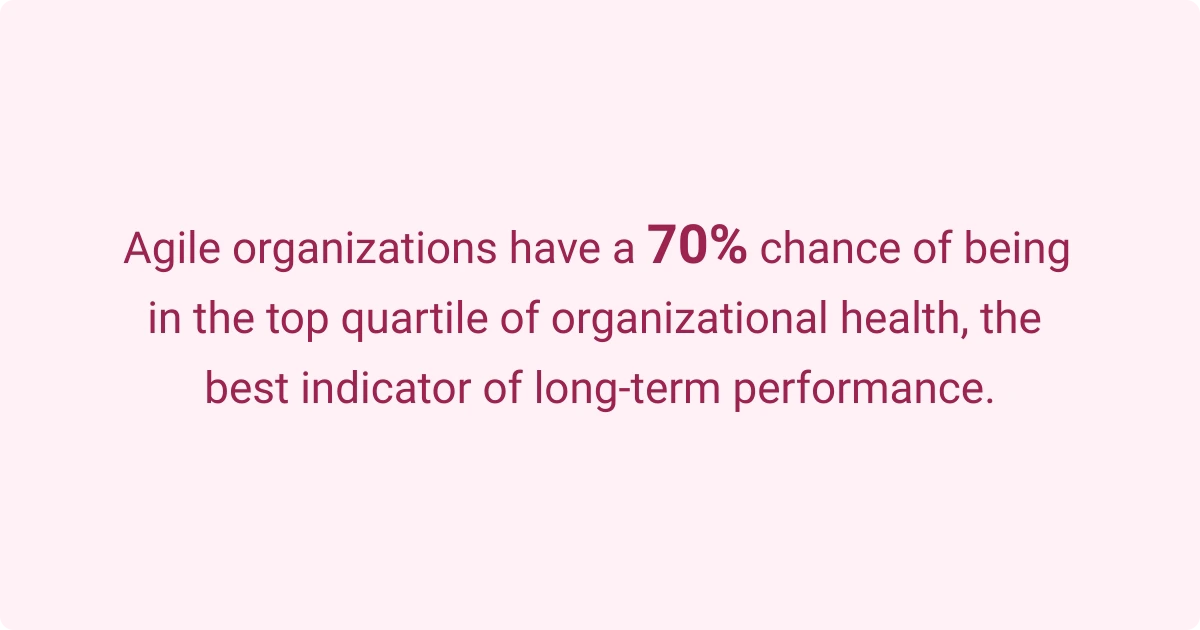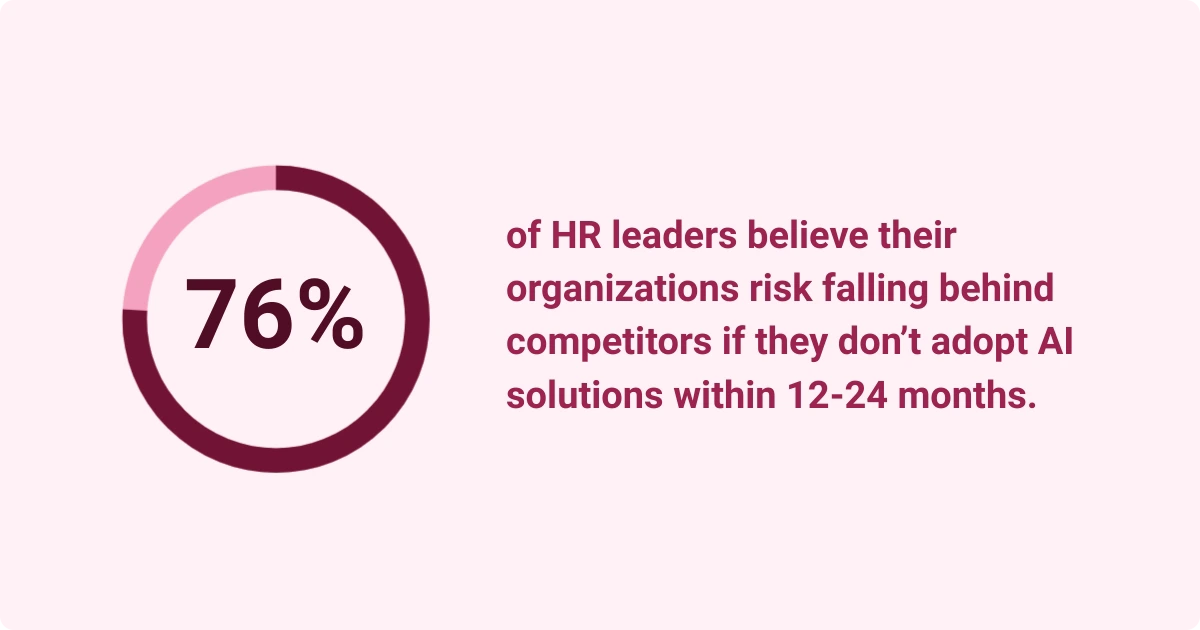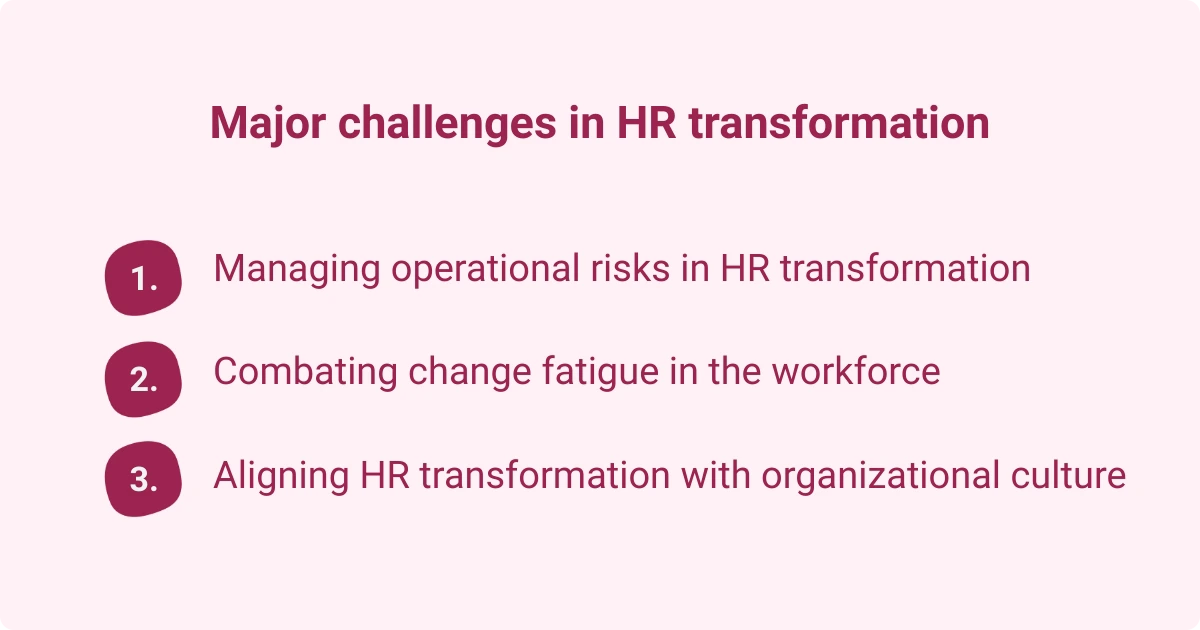HR Transformation: How to Lead Your Organization Into the Future
Table of contents

From complex hybrid work models to operational risks, the most significant challenges in human resources (HR) are changing with the times. Adopting HR transformation will help your organization stay ahead in today's evolving business environment.
The best digital transformations are customized around each company's culture, digital interface, and existing practices. So, there's no universal solution for transforming your approach to HR. Instead, you must consider your organization's most significant drivers and goals.
What is HR transformation?
HR transformation is the process of reshaping your organization's approach to people management and interpersonal relationships. This often involves adjusting policies, replacing software, and adopting new people-centric practices. These changes should leverage human resource technology and improve employees' experiences while aligning with your organization's goals.
HR transformation differs from traditional HR practices because it focuses more on the bigger picture, such as how to address all employees rather than individuals. Effective HR transformation requires you to rethink the human resources role within your organization. HR shouldn't just be a department but a strategic partner supporting the business's objectives.
Examples of HR transformation include:
- Digital transformation: Reconsider your organization's software and technology, such as artificial intelligence (AI) and automation, and use analytics to reassess your people management.
- Strategic transformation: Reevaluate and overhaul HR's overall role to align with your business's goals, such as by adopting new long-term initiatives.
- Operational transformation: Adjust HR's workflows and practices to streamline all processes, from payroll to reports.
Why is HR transformation important?
Effective HR transformation helps your business stay ahead of today's rapidly changing business environment. It's essential for many human resources practices, including:
- Addressing new workforce needs
- Improving employee engagement and decreasing absenteeism
- Driving higher sales and returns on assets
- Adopting new technology and software
Addressing modern workforce needs
From remote work to AI advancements, today's workforce is quite different from the one we knew ten years ago. Adapting HR to modern challenges helps you make decisions that support your goals and team.
For example, while remote work was many companies' only option in 2020, many businesses and industries have tugged between hybrid and fully in-person work in the years since. Though some people genuinely missed the office, hybrid and remote schedules generally improved employee satisfaction.
"Return to work" mandates led to decreased employee retention and "quiet quitting", which is when employees complete the bare minimum work to avoid being fired.
HR transformation should also support diversity, equity, and inclusion (DEI) initiatives, which open your business up to new ideas, perspectives, and opportunities. Despite their benefits, many initiatives make it challenging to address workplace inequities beyond the pre-determined DEI goals. HR transformation reassesses how you approach these initiatives to ensure they actually benefit everyone they need to.
Driving organizational performance
Employee-focused HR transformation improves efficiency, cost savings, employee engagement, and job retention in various ways. For instance, a new HR initiative that recognizes employees' achievements can make them feel more appreciated, which can boost retention. It can also motivate them and other teammates to work harder, improving engagement and productivity.
Businesses with high employee experience scores often have significantly higher returns on sales and assets, higher productivity, and lower absenteeism. Many of the best people-centered initiatives focus on teams' sense of happiness, belonging, purpose, achievement, and motivation.
HR transformation also optimizes talent management processes, such as your recruitment processes, to help you build a stronger workforce as your organization grows.
Adapting to technological advancements
AI, automation, new software, and HR analytics are changing the future of HR. Using analytics tools, such as Workhuman, can help you embrace the importance of HR transformation by identifying new goals, risks, and employee preferences.
The right technology lets you make more accurate decisions for your teams, such as limiting the negative effects of new software. Automation and other technology also reduce administrative tasks and improve HR's overall efficiency.
What are the key drivers for HR transformation?
A successful HR transformation requires you to consider your organization's key drivers, including:
- Robust leadership
- Operating models
- Effective communication
- Data and analytics
- HR technology
Leadership's role in HR transformation
Leadership plays a crucial role in practically every new initiative, though they can make or break your HR transformation. For instance, when adopting software, leaders who genuinely understand the technology often inspire better productivity and innovationOpens in a new tab. On the other hand, employees may not care enough to understand their new programs and practices if their boss doesn't take the time, either.
HR leaders can drive organizational change by taking the first steps when adopting new technology, practices, and long-term goals. This means leading by example and, in some cases, being the go-to for everyone's questions.
Redefining the HR operating model
Your HR operating model defines your team's structure, roles, and key processes. Even the most effective operating models must eventually change to keep up with industry shifts and support new business requirements.
An agile operating model keeps your business ahead of the curve with DEI initiatives, employee experiences, competitive salaries, and other strategies. For example, adopting a pay structure based on skills and experiences can boost employee retention better than traditional, role-based pay.

Building essential HR skills and capabilities
HR teams must develop new skills to support their transformation goals. Focusing on communication can help you rethink how you share information with hybrid and remote employees. On the other hand, a better understanding of data analytics lets you manage heavy amounts of data for large teams.
Beneficial HR skills include:
- Communication and active listening
- Conflict resolution
- Strategic business partnerships
- Data analytics and analytic reasoning
- Technology
- Organization
Utilizing HR technology for maximum impact
HR technology, such as hr reporting and analytics tools, can streamline your work processes in many ways. On a basic level, digital documents and secure cloud platforms can save you from manually completing forms or physically storing them in locked filing cabinets.
Beyond that, automation, AI, and analytics tools make it easier to utilize heavy amounts of information. These technologies can help you understand employees' motivations and make important decisions, such as when choosing the best job candidate.

Stages of HR digital transformation
Though there's no all-inclusive blueprint, most HR transformations follow similar change management and communication strategies. The general stages of HR digital transformation include:
- Evaluating HR operations
- Establishing a transformation blueprint
- Implementing and communicating the transformation
- Tracking successes and updating best practices
Evaluating current HR operations and capabilities
First and foremost, reassess your existing HR processes and systems. Identify your current capabilities and all potential gaps, such as practices that could be more effective or goals you aren't contributing to at all. Analytics tools can highlight particular areas for improvement and your organization's best assets.
Crafting the HR transformation blueprint
A comprehensive transformation plan requires many factors, including:
- Key stages and milestones: Set realistic steps for your HR goals, such as choosing new practices, introducing new practices to teams, and overseeing implementation.
- Measurable goals: Measurable goals help you track your success and reevaluate key processes over time. Examples include employee survey scores, sales, and employee retention.
- Budget and resource requirements: Compare your organization's goals with its capabilities and capacity to establish that you have the resources to achieve your goals.
Managing change and preparing the workforce
How you implement new practices and technology can significantly impact their effectiveness over time. This is why it's essential to start your HR transformation on the right foot, whether you're introducing a new policy or industry-standard technology.
A customized change management and communication strategy can help your employees transition. Additionally, consider investing in comprehensive training for employees or your HR team, especially when adopting complex software or practices.
Ongoing monitoring and enhancement
Tracking your measurable goals and monitoring progress can help you identify your most and least successful implementation strategies. This can help you address immediate issues, such as sharing software instructions you hadn't included. Plus, it can help you establish better change management and communication strategies moving forward.
Beyond basic analytics, you should regularly gather feedback from employees and stakeholders. This can help you identify areas for improvement beyond the numbers. It also gives you insight into how people perceive your efforts.
HR transformation in practice: real-world examples
Recent case studies highlight the best HR practices during digital transformations. These real-life stories can establish a clear frame of reference when adopting transformations of your own.
Energy industry case study
A 2023 study explored the variables impacting successful digital transformationsOpens in a new tab across 110 energy companies. It revealed that HR plays a significant role in organizations' readiness, such as by preparing teams for new initiatives and promoting them positively. A healthy culture and a skilled workforce will be much more prepared for and willing to adopt digital transformations.
Factors that benefit digital transformations include:
- Employee qualifications
- Employee education and knowledge
- Existing practices and operations
- Brand and reputation
The study also highlighted the importance of financial and technological resources. Tools such as communication software and digital storage can keep teams on the same page without them losing any important files. Additionally, financial contingency prepares your organization for potential setbacks or risks associated with your transformation. After all, you can't put all your eggs in one basket.
HR transformation for business survival
A study of human resource digital transformationOpens in a new tab explored the impacts of HR transformations during complex scenarios, such as COVID-19 and drastic market shifts. Using data from over 20 multinational HR professionals, the study concluded that organizations must continuously upgrade their operations to prepare for sudden changes.
The study suggested that many organizations only started prioritizing digital transformation following the COVID-19 pandemic, which most companies were unprepared for. This increased demand led to an increase in digital HR solutions. These give HR leaders more control over their organizations' digital architecture, streamlining communication and maximizing operations regardless of where employees work.
This case study also focused on how human intervention boosts operational efficiency. From a human resources perspective, HR should be fully involved in digital transformations and help any employees who are struggling.
Beyond that, adopting AI and other technologies limits the administrative tasks put on HR, leadership, and employees. While this is beneficial, employees should still be involved in many processes, such as double-checking data, to limit risks and errors.
Overcoming challenges in HR transformation
Though HR transformations pose opportunities for growth and career development, you must always prepare for potential setbacks and risks.

Managing operational risks in HR transformation
Project delays, cost overruns, integration issues, and other operational risks can set your organization and your efforts back throughout the HR transformation process. For instance, even if a new reporting software is meant to speed things up, employees will reasonably need time to learn the program's new mechanics. This will most likely result in a dip in productivity, though it likely won't be permanent.
By identifying these risks early on, organizations can enact strategies to mitigate them or, at least, decrease their impacts. For instance, if you know employees will need time to learn a new process, schedule training and implementation during your business's slowest weeks.
Combating change fatigue in the workforce
Change fatigue occurs when employees resist adjustments to their workflows, which is especially common when taking on several repeated changes or multiple changes at once. Examples of change fatigue can include an employee not fully embracing a new app or someone "quiet quitting" because of a schedule change.
Establishing clear communication, recognizing milestones, and listening to employees' thoughts can help them feel more included throughout the transformation. Other strategies include:
- Explaining the importance and significance of new changes
- Sharing how new technology and practices can benefit employees' workflows
- Setting rewards and prizes for transformation milestones
- Decreasing employees' deadlines and stressors as they adjust
Aligning HR transformation with organizational culture
As mentioned, your team's culture and career goals significantly impact your transformation success. Employees with diverse skill sets may be more willing and capable of adopting new practices and technology, especially if they have compatible experience.
Rather than disrupt your existing company culture, your digital transformation should align with your team's current values. For example, if your teams are functioning faster than ever due to a hybrid schedule, you should avoid impacting employees' hours with your new protocols.
Lead your organization into the future with HR transformation
Digital HR transformations have become essential in today's fast-paced, technology-driven industries. Effective transformations help your business address modern workforce needs, adapt to new advancements, and drive better performances.
Workhuman gives you insight into your teams' analytics, letting you monitor every step of your digital transformation. Embrace innovation in human resources by starting your new initiative on the right foot.